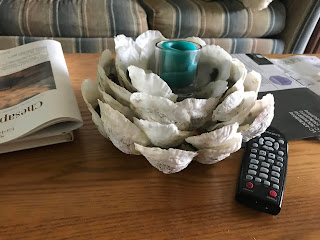This past Saturday Deltaville held "Deltaville Days". Saturday and Sunday the marinas and boatyards hold open houses. Deltaville Yachting Center, DYC, had music and free oysters on the half shell. We could not have chosen a a better marina to host our boat since Tom loves oysters on the half shell. The reception area was set up at the front of the marina which just so happened to be straight across from us. From time to time Tom would mosey over from the boat for an oyster. There didn't seem to be many people stopping by so Tom figured it wasn't a problem to make multiple visits for an oyster. Late in the afternoon just before closing Tom seemed to be MIA. It wasn't to hard to figure out where to look first. There, under the tent cover, visiting with the oyster man sat Tom. Upon his return to the boat he proudly announced that the gentlemen serving oysters was Don and Don has an oyster farm. Not being a lover of oysters my response was less than enthusiastic. But then Tom announced that we were invited to visit his little farm. Now I was interested. I may not eat them but I was interested in learning how someone goes about growing oysters. Our visit the next week was great. I learned a lot but was still not convinced to eat one.
A few facts: If the water freezes the oysters will go into hibernation which makes chances of
survival good.
If the water is low such as low tide and there are no waves lapping the
the bags they will not survive.
These oysters are called triploid oysters, they are highly resistive to disease, grow
fast and are sterile, which means that instead of using their energy to reproduce
they use all of it to grow. This allows them to grow twice as fast and be harvested
all year round.
if the salinity of the water goes below .5 the oysters will die. This year has been a
problem because the high amounts of rainfall.
Bags of Oyster Shells are stacked in his yard. He sells them and they are also used to help
establish new oyster beds in the area.
This is a view of his gentleman oyster farm from his yard. The oysters are in bags that
are floating just below the waters surface.
Oysters being kept in a strainer bucket in the water
Each of these mesh bags holds about 200 oysters. if more are stuffed in the bags there
will not be enough water flow to sustain them.
Don loves sharing information about his oyster farm and oyster farming in general.
He talks to schools and organizations about the positive effect oysters have on the bay.
Oysters filter the water, which improves the quality of the water in the Bay.
These are samples of baby oysters. These did not survive. Don had purchased 100,00
that morning.
As the oysters grow he changes the size of the mesh bags. Each bag has different sized holes.
He sifts(shakes) the babies once per week and flips the bag. After a period of growth he
moves them to a larger bag. The bag is then sifted, those that fall out go back in the bags with
the small holes. The older oysters are sifted and flipped every two weeks. It takes 11/2 - 3
yrs, for them to be large enough(3 inches) to harvest and sell. Don uses 2 liter water bottles
filled with water, frozen then tied to the bags as floatation devices.
Tom bought 2 dozen oysters straight from the water. Don hosed them off for him. Don
also has an area in another creek he manages. He sells about 100,000 oysters a year. He
told us he will ship 100 oysters for $100.
Toms take home
Shipping boxes for the oysters.
Dons wife makes things out of the oyster shells
This is one of the baby oyster bags. They are double bagged to keep the crabs,
otters and rays from eating them.














No comments:
Post a Comment